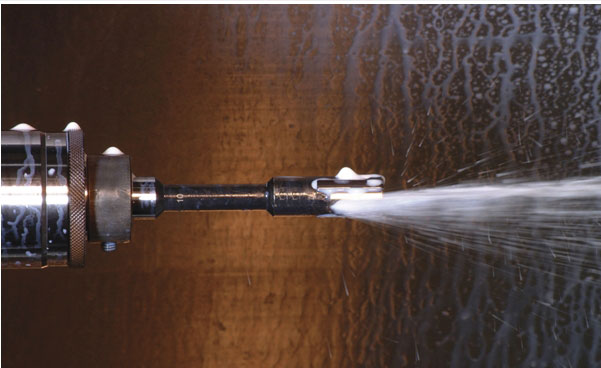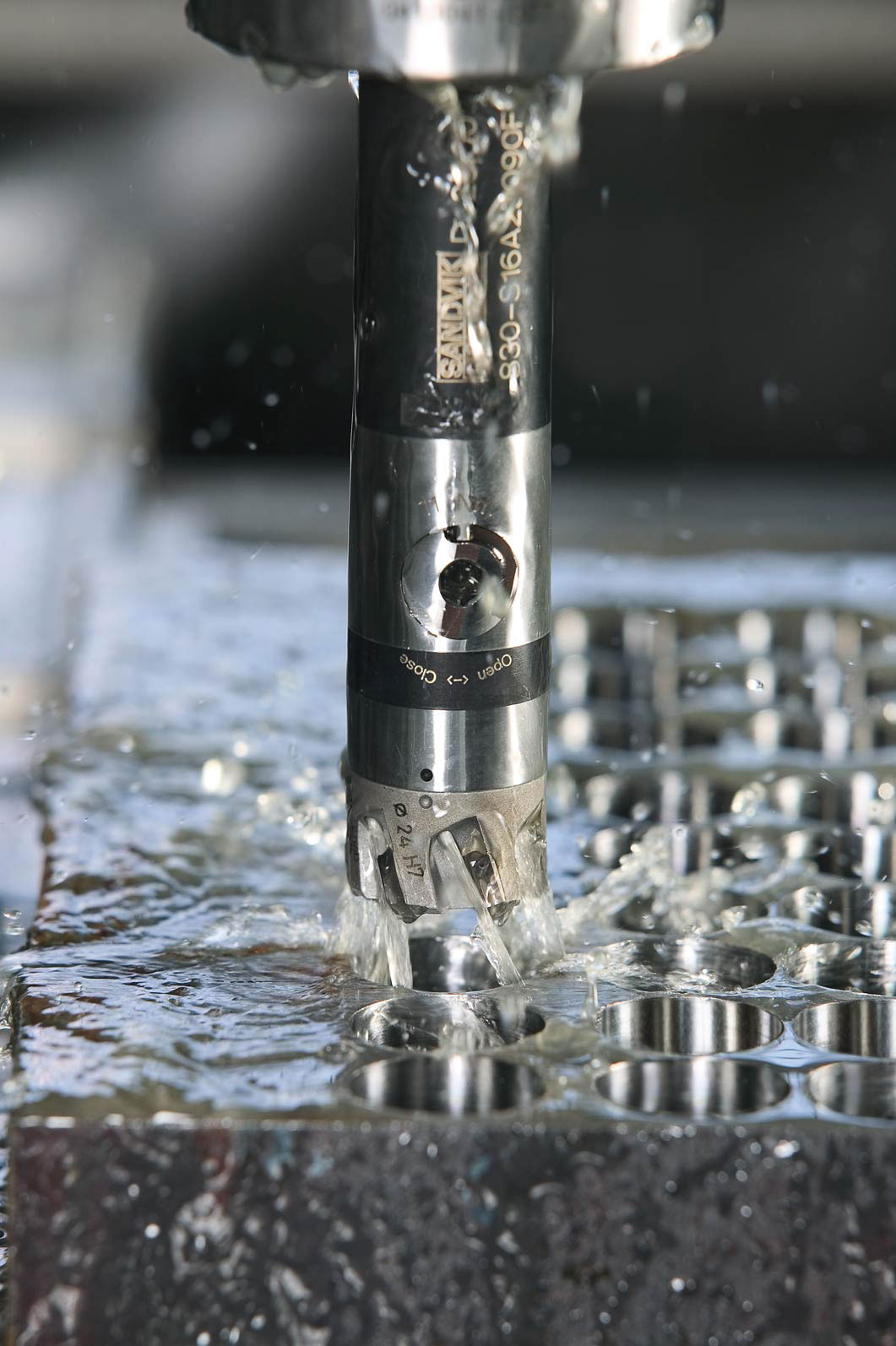by Kip Hanson
Cutting tool manufacturers weigh in on the benefits of reaming
It was 1981 and I was setting up a Hardinge screw machine to turn some stainless steel fuel nozzles. The drawing called for a 1/4 in. (6 mm) blind hole nearly 2 in. (50 mm) in depth, with a +/-.0005 in. (.0012 mm) tolerance on the diameter. There was no chance of boring that deep, so I mounted a reamer into a Brookfield holder, floated it on centre, set the length and pushed cycle start. So far, so good.
Imagine my surprise when smoke came pouring out of the machine several minutes later, followed by an awful squealing as the reamer caught in the hole and spun. The workpiece was glowing orange like a tangerine by the time I hit the panic button. Apparently I’d drilled the starter hole a bit too small and the chips packed up in front of the reamer, causing it to seize. My boss was none too happy about the overnight delivery charge for new reamers, never mind the melted holder.
Despite this memorable experience, I’ve reamed thousands of holes since then, with satisfactory results. Much has changed over the years, however. Double-margin, coolant fed carbide drills offer such excellent hole quality that reaming is often unnecessary. And ultra-precise modular boring heads are a flexible option for the hole finishing needs of many job shops, eliminating the need for reamers of every size imaginable. Some might say these multi-fluted senior citizens are going the way of disco music and floppy disks
Reamers revival?
Far from it. Mike Smith, product manager for reaming, boring and tooling systems at Seco Tools Inc. says reaming is on the upswing. “We’ve seen double-digit growth in our reaming business over the last few years. Especially with larger work, where reamers are more cost effective than boring, it’s becoming increasingly prevalent.”
 Smith agrees basic reamer geometry hasn’t changed all that much over the decades, but cutting tool manufacturers have begun utilizing modern coatings and carbides, greatly boosting tool life and performance. Add to that indexable reamers capable of hole sizes up to 8 in. (400 mm) diameter, reamers that utilize replaceable carbide heads, and micro-adjustable reamers that allow for compensation of tool wear and in-between sizes.
Smith agrees basic reamer geometry hasn’t changed all that much over the decades, but cutting tool manufacturers have begun utilizing modern coatings and carbides, greatly boosting tool life and performance. Add to that indexable reamers capable of hole sizes up to 8 in. (400 mm) diameter, reamers that utilize replaceable carbide heads, and micro-adjustable reamers that allow for compensation of tool wear and in-between sizes.
“Many of those customers who were once boring parts to size have switched to reaming,” Smith says. “They get better tool life, and no longer have to waste time adjusting a boring head. That said, it really comes down to production volumes. If you only have to make 50 holes, you’re probably still better off boring. If you’re talking 5,000 or more, then that’s where an indexable reamer system really pays for itself.”
Kennametal Inc.’s regional product manager for holemaking, Steve Pilger, agrees. “Typically, you use a reamer in close tolerance, high volume applications. One example of this is automotive, where reamers are often used in engine production. Compared to a boring bar, you have a multi-flute cutting tool that can be fed much faster. Reamers offer some quality advantages as well, such as excellent surface finishes and much rounder holes.”
As Pilger explains, a reamer’s multiple flutes means you don’t run into problems with wear in one spot, as you do with single-tipped boring heads. And bore depths of more than 3-4 x diameter often leads to taper and chatter, whereas reamers don’t have this limitation. “Simply pop an extension onto the reamer body and you have beautiful, round holes to virtually any depth.”
Boring head aficionados will argue that a reaming strategy requires more tools in the crib, one for every hole size. While this may be true for very small holes, expansion reamers are available from a number of manufacturers, from around 5/16 in. diameter (8 mm) and up. Kennametal’s version, the RMB-E and RHM-E series, expands in fixed 2µ increments for every 30° turn of a set screw, and Seco’s Xfix reaming solution offers similar functionality starting at 1.55 in. (39.5 mm) diameter.
 Kennametal’s Pilger warns that care must be taken with traditional expansion reamers to avoid over-expanding. “Tighten them too much and you lose the back taper. When you lose back taper you’ve lost pretty much everything. Kennametal avoids this problem with a built-in safety stop, limiting expansion to three times the tool’s IT6 tolerance limit.”
Kennametal’s Pilger warns that care must be taken with traditional expansion reamers to avoid over-expanding. “Tighten them too much and you lose the back taper. When you lose back taper you’ve lost pretty much everything. Kennametal avoids this problem with a built-in safety stop, limiting expansion to three times the tool’s IT6 tolerance limit.”
Randy McEachern, product and application specialist for Sandvik Coromant Canada Inc., explains that reaming has evolved from simple high speed steel tools to high performance hole finishers available in solid carbide, cermet and even PCD-style (polycrystalline diamond) reamers, covering the full range of materials used in the aerospace, power generation, and automotive industries.
Toolmakers have done much to make these tools fast, predictable and easy to use. “Boring heads, for example, often require assembly of multiple components, and machine operators need training on how to use them,” McEachern says. “By comparison, reamers are much easier to setup and run.”
He points to Sandvik Coromant’s modular CoroReamer 830 as proof. The 830 utilizes a replaceable cutting head, one that mounts to the shank with a tapered coupling arrangement. This guarantees radial run-out of no more than 3µm (120µ in.), while still assuring fast changeover.
“Minimizing runout is critical to reaming success,” McEachern says. “To accomplish this, always use a high quality hydraulic chuck, and the shortest possible tool overhang.”
Mark Rubemeyer, senior applications engineer at Missouri-based Hannibal Carbide Tool Inc. suggests a similar approach to toolholding, adding that shrinkfit holders are also a good way to avoid oversize holes. “If you have run out anywhere—the tool shank, the holder or spindle, the reamer will likely cut a big hole.”
Surprisingly, Rubemeyer says one of the most popular ways to hold a reamer remains a collet chuck. This may be fine for general purpose work, but for the best reaming results, he recommends a coolant-fed tool with an H6 shank, designed exclusively for shrinkfit holders.
This last point—coolant through-the-tool—is a feature that was unavailable back in the day of my melted reamer experience. Each of the cutting tool manufacturers interviewed for this article recommend coolant pressure of at least 15 bar (200 psi), although none would argue that more is better when it comes to pushing chips out of the hole.
Cutting geometry plays a big part in chip evacuation as well. For blind holes, Rubemeyer suggests a straight flute reamer as the best way to pull chips out of the hole and avoid packing. For through holes, a spiral flute works best, as these tend to push chips ahead of the tool. In both cases, a good supply of clean, water-soluble cutting fluid is your best bet to avoid heat and premature tool wear.
The point angle is an often-overlooked area of reamer geometry. Where a standard 45° chamfer is largely the industry norm, Rubemeyer says there are instances where you might want to flatten the end. “If you have some drill walk, for example, a flat end on the reamer—sort of like an end mill—is good for straightening the hole.”
A radiused cutting edge is another of Rubemeyer’s ways to teach old reamers new tricks. “This can provide a superior surface finish, because the flutes have a more gradual transition to the tool’s outer diameter. It eliminates the sharp point, which is the first part of the tool to break down during cutting.”
Special geometries such as these are the exception to the rule, he cautions. “There’s no reason to reinvent the wheel. Nine times out of ten, a standard reamer will do the job for which it was designed, which is to provide a smooth, accurate hole, and do so quickly and cost effectively.”
From your grandfather’s basic HSS chucking reamer to today’s high tech, modular systems, it’s clear that reamers are a viable solution for a large percentage of manufacturing’s hole finishing needs. Reamers have withstood the test of time, and continue to become more effective as cutting tool providers invest in their development. Maybe you should take another look at the humble reamer. SMT
Kip Hanson is a contributing editor. [email protected]
